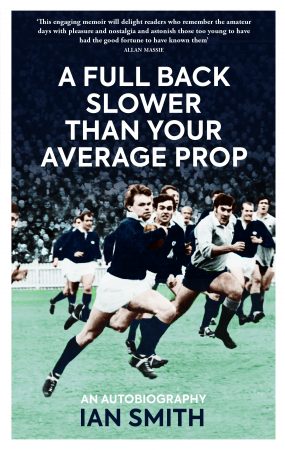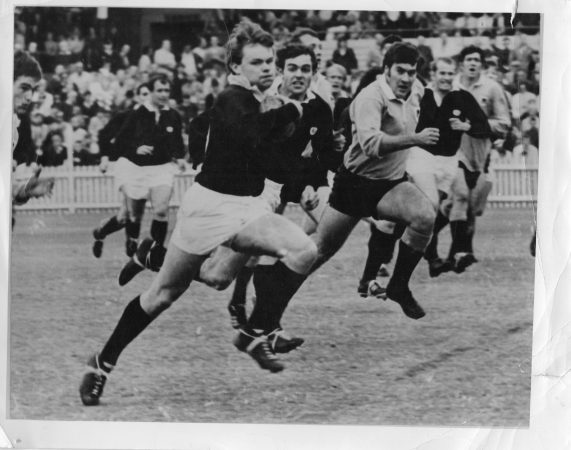Former Scotland full-back Ian Smith is perfectly happy to play up his limitations. But amid the frazzled nerves and sceptical selectors is an outstanding autobiography
Book review: The self-roast of Ian Smith
Ian Smith learnt he had been picked for Scotland when a Daily Mail reporter, the late Terry O’Connor, rang him at home. “Congratulations,” he said to Smith, “but who are you?”
Since Smith was playing for London Scottish 3rds at the time, it was a fair enough question. Smith was to win nine Test caps, the last of them for Hong Kong, from 1969-72. He became the first Scotland full-back to score an international try, a late three-pointer that did for the Springboks on his debut at Murrayfield. He scored again in his next outing against France.
If that all sounds a bit ‘boy’s own’, let us disavail you. Smith’s career was far more about fears and insecurity, put-downs and rejection. One correspondent called him one of the six worst international rugby selections of all time. “He may well have been right!” Smith says.

Magic moment: Smith (left) scores the winning try on his Scotland debut to beat South Africa 6-3 in 1969
The Dundee-born Scot cheerfully explores all this in his stunningly good autobiography A Full-Back Slower Than Your Average Prop. The title alludes to a disparaging remark about his pace, the player being told to stay out of the line because he “slowed everyone down”.
It’s a book that engages you on many levels. For starters, it takes you back to a time devoid of computers and mobile phones, washing machines and freezers. Not everyone had a television and rugby coverage on the box was scarce.
Thus, after Smith had a strong game for Combined Services, the Scotland selectors planned a trip south en masse. They wanted to watch him play for London Scottish to see if the previous week’s performance had just been a fluke! As it happens, the match was cancelled.

Proud: Smith took a while to make London Scottish’s first XV
After being capped by Scotland, Smith was promoted to the first XV at London Scottish only because it was club policy to do so. It meant moving the first XV captain, Gordon Macdonald (a brief Scotland cap), to fly-half. He didn’t speak to Smith for the rest of that season.
Of course, it worked both ways. When Smith was later axed by Scotland, he was also dropped by London Scottish, the Army and Combined Services. All in a ten-day period!
Smith’s self-deprecating humour punctuates the pages. You only have to look at the chapter headings to see his slant on things: You are too small to be a centre. You have to be a lot quicker if this is going to work. What do you mean you dropped 14 balls? You are too fat and idle to play at this level.
In the summer of 1969, when he was consuming a full English fried breakfast and seven pints of full-cream milk daily, Smith’s weight ballooned to over 15st.
He got his Scotland chance after injuries to others and was labelled ‘lucky’. But, of course, there are no muppets on the Test stage. There are insights into the skill acquisition that enabled him to reach the highest level. Training in poor light at university was one surprising benefit; it improved his catching because seeing the ball late sharpened his reactions.
Earlier, as a schoolboy at George Heriot’s in Edinburgh, he would climb over the wall of George Watson’s to practise kicking with a boy from that college. He later discovered that boy was Ian Robertson, a future Scotland team-mate and broadcasting great.
Smith learnt how to screw-kick at a camp run by the Scottish Schoolboys Club and says he was eventually able to achieve perfect execution nine times out of ten.

Into touch: tackling England wing John Novak. Ian Robertson (with hair) and Ali Biggar support
In the Sixties, full-back was a purely defensive position. You were expected to catch, kick and tackle but not attack. That changed when the Australian Dispensation Law banning direct kicking into touch outside the 25 (now 22) was introduced.
Step forward Harry Rea, an “inventive genius” who proposed a series of moves that, by modern standards, seem very simple. Yet at the time no one had seen anything like it.
Rea, a twice-capped Irish centre, was at Edinburgh University and for a couple of years, 1967 and 1968, the student side ran riot against the best club sides in England and Scotland. Ian Smith, studying dentistry, was part of that team.
There were three basic moves: miss one (ten passes to 13), miss two (12 passes to 15), and a dummy scissors (between ten and 12, followed by a pass to 13).

Student gig: the Edinburgh University team of 1967-68, with Smith seated just to the right of the captain
With no such thing as analysis then, and no TV coverage of Edinburgh University, they were able to bemuse team after team. For example, they crushed mighty Bedford 20-0 away even though they were up all night at a ball whilst their opponents were tucked up in bed.
The try Smith scored to beat the Boks came from a dummy scissors move called by Robertson, and the try he scored against France was from a ‘miss two’ move. What fun a modern-day analyst would have if he was able to go back 50 years in a time tunnel!
Another engrossing topic in Smith’s book concerns the fear factor. “It’s not something you often read about in autobiographies, but I need to be honest about how I felt,” he writes.
“As a full-back there was the fear as I waited under the first high ball of the season, the first high ball of a match. I prayed that no one ever saw the fear I felt, and that my ability was up to the task of catching that ball and taking whatever tackles and blows came as a result without flinching.
“Was it better to be brave, stand your ground and drop a high ball, or just not quite be in the right place, leaving another to take what was rightfully yours and thus appear blameless?”

Happy family: a Christmas gathering in 2017. Smith lives in Norfolk, where he ended his playing days
This fear never left him. When, in the week of the 1970 Calcutta Cup match, someone remarked on Sportsnight that Smith had “never been tested under the high ball”, he was physically sick. He then suffered three sleepless nights dreading what the English fly-half, Roger Shackleton, might do to him that Saturday.
A year later, he made himself available for the game with Wales despite having a shoulder injury. He didn’t want to risk losing his place if he pulled out. In what proved one of the epic matches, won by John Taylor’s touchline conversion, Smith admits startlingly: “I proceeded to not be in quite the right place for most of the Welsh tries so I didn’t have to tackle.”
Ultimately, the “mental torture”, of recalling past mistakes and the prospect of making new ones, brought a permanent end to his Test career. He asked for an overseas posting with the Army so that he wouldn’t be available for Scotland.
There are a number of light-hearted tales to go with the serious introspection; a few interesting views too on the flaws of modern rugby. Like we say, the book engages on many levels and it is all the better for that.

After some adventures in Hong Kong, Ian Smith moved to East Anglia. He played his final game of rugby for West Norfolk 2nds. Seeing that the opposition had turned their backs at a penalty award, he tried a ‘tap and go’ from distance. He was just able to stagger over the line for a try but promptly threw up over the referee’s boots!
A Full-Back Slower Than Your Average Prop by Ian Smith is published by Arena Sport, RRP £17.99, and comes highly recommended.
Follow Rugby World on Facebook, Instagram and Twitter.





